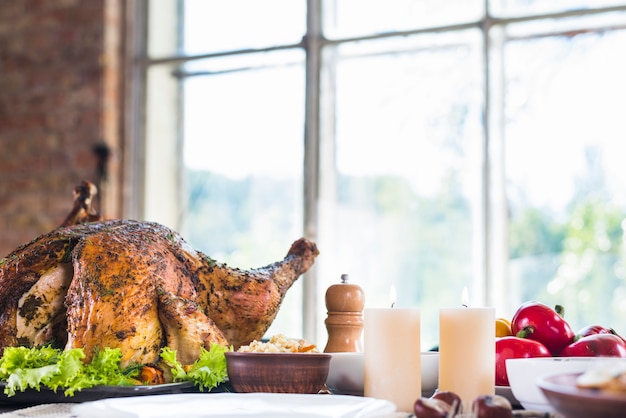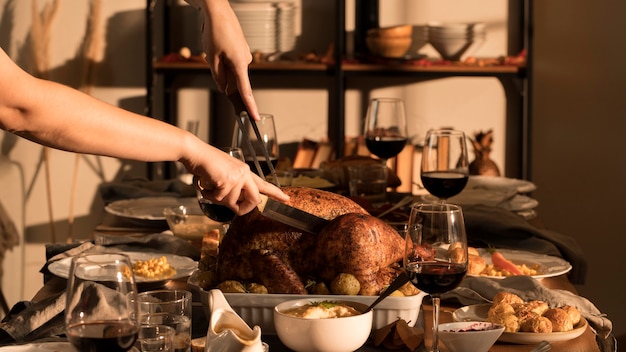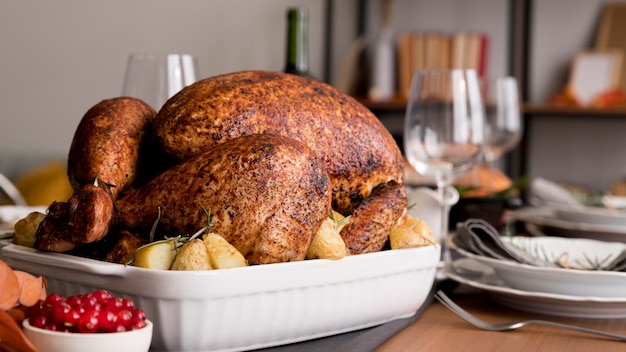Right, let’s talk turkeys. The festive season is upon us, and it’s that time of year again! As always, the annual turkey conundrum arises – how long do you cook it for? What temperature should it be? And most importantly, how do you ensure it’s cooked to perfection without turning into a dry, leathery monstrosity?
Well, fear not, because I’ve got you covered! I’ve been roasting turkeys for years, and I’ve learned a thing or two along the way. I’ve had my fair share of disasters – like the time I accidentally left the turkey in the oven for an hour longer than I should have, resulting in a crispy bird that was practically inedible. But I’ve also had some triumphs, like the year I managed to roast a turkey so juicy and flavorful it was declared the best ever by my family (and my in-laws – that's a feat in itself!).
So, let’s dive into the turkey roasting time saga. I’ll break it down step by step, offering tips and tricks I’ve picked up over the years.
(Part 1) Unstuffed turkey roasting: A Guide for Perfection

First things first, we’re focusing on unstuffed turkeys. Why? Because stuffing the turkey can actually make it take longer to cook and it also increases the risk of food poisoning if it’s not cooked thoroughly. Trust me, you don’t want to be dealing with that on Christmas Day!
1. Getting Started: Choosing Your Turkey
Before you even think about roasting, you need to pick your turkey. Here’s what you need to know:
- Size Matters: Choose a turkey that’s big enough to feed everyone, but not so big that you'll have leftovers for weeks. I usually go for a turkey that's about 10-12 pounds, which is enough for 6-8 people. But it really depends on your appetite! Remember, a larger bird will require a longer cooking time.
- Fresh or Frozen?: Fresh turkeys are great, but they require more planning as they need to be cooked within a couple of days of purchase. frozen turkeys are more convenient, but they need to be defrosted properly before cooking. You can defrost it in the fridge or cold water, but make sure it's thawed completely before cooking. Remember, the size of the bird will determine how long it takes to defrost. A good rule of thumb is to allow at least 24 hours for every 5 pounds of turkey.
- Turkey Types: There are a few different types of turkeys to choose from, like regular turkeys, free-range turkeys, and heritage breed turkeys. Choose the one that fits your preferences. Personally, I always go for free-range turkeys, as they tend to have a more flavorful meat.
2. The Importance of Brining
Okay, now that you've got your turkey, it's time to get into the magic of brining. Now, I know what you're thinking: "Brining? Isn’t that a bit fussy?" But trust me, it's worth the effort. Brining your turkey helps to make it juicy and flavorful, and it also makes it more forgiving if you happen to overcook it slightly.
- Why Bother? Brining essentially involves soaking your turkey in a salt solution, which helps to draw moisture into the meat. It's a bit like giving your turkey a spa day.
- Brining Options: There are plenty of brining recipes out there, but my favourite is a simple salt and sugar solution. Just mix salt and sugar in water and soak your turkey for 12-24 hours. You can even add herbs and spices for extra flavor. Experiment with different combinations to find what you enjoy the most.
- Safety Note: Remember, it's crucial to ensure that your brining solution is kept in the fridge, as it's prone to bacterial growth at room temperature.
3. The Roasting Process: A Step-by-Step Guide
Now, let’s get into the roasting. Here’s how to do it:
- Preheat the Oven: Preheat your oven to 325 degrees Fahrenheit (163 degrees Celsius). Make sure you give it plenty of time to reach the desired temperature. This is crucial for ensuring even cooking.
- Prepare the Turkey: Remove the turkey from the fridge and pat it dry with paper towels. Now, it’s time to get into the fun part – seasoning. I like to use a simple combination of salt, pepper, and herbs, like rosemary, thyme, or sage. You can also add other spices, like paprika or garlic powder. Just experiment to find a combination you love.
- Roasting Time: Now, for the big question: how long do you cook it for? Well, that depends on the size of your turkey. A good rule of thumb is to allow 15 minutes per pound of turkey for an unstuffed bird. For example, a 12-pound turkey will need to cook for about 3 hours.
- Basting, Basting, Basting: While it’s roasting, you’ll want to baste the turkey every 30-45 minutes. This helps to keep the meat moist and flavorful. You can use pan drippings or even butter.
- Rest Time: Once the turkey is cooked, let it rest for at least 20 minutes before carving. This allows the juices to redistribute, resulting in a juicier, more flavorful turkey.
4. Checking for Doneness: Using a meat thermometer
How do you know when your turkey is cooked? Well, the old-fashioned way of checking for doneness by sticking a knife in and seeing if the juices run clear doesn’t always work. The best way is to use a meat thermometer.
- Where to Insert: Insert the thermometer into the thickest part of the thigh, making sure it doesn’t touch any bone.
- Temperature Matters: The turkey is fully cooked when the internal temperature reaches 165 degrees Fahrenheit (74 degrees Celsius).
- Don’t Overcook: Be careful not to overcook the turkey, as this can lead to dry meat.
(Part 2) Turkey Roasting Time: The Essentials

Let’s get into some more specifics about roasting time.
1. turkey roasting time chart
Here’s a handy table to help you determine the roasting time based on the weight of your turkey:
| turkey weight (lbs) | Roasting Time (hrs) |
|---|---|
| 8-10 | 2.5-3 |
| 10-12 | 3-3.5 |
| 12-14 | 3.5-4 |
| 14-16 | 4-4.5 |
| 16-18 | 4.5-5 |
2. Factors Affecting Roasting Time
Keep in mind that these are just estimates. There are a few factors that can affect the roasting time, such as:
- Oven Temperature: Always use a meat thermometer to check for doneness, as oven temperatures can vary.
- Type of Oven: Different types of ovens, such as gas or electric ovens, can cook at slightly different temperatures.
- Turkey Shape: If your turkey has a different shape or is particularly large, it might take a little longer to cook.
3. Alternative Roasting Methods
Here are a few other ways to cook your turkey, if roasting isn’t your cup of tea:
- Deep Frying: This method can cut down on the cooking time significantly, but be sure to follow safety guidelines closely. Deep frying can be a faster alternative but it’s crucial to take safety precautions.
- slow roasting: This is a great way to ensure a moist, flavorful turkey. Just lower the oven temperature to 275 degrees Fahrenheit (135 degrees Celsius) and cook for longer.
- Smoking: This is a great way to add a smoky flavor to your turkey. You can use a smoker or a grill with a smoker box.
(Part 3) Turkey Roasting: Tips and Tricks

Now for some helpful tips and tricks to ensure your turkey is a success:
1. roasting pan: The Right Choice
Make sure you have a large roasting pan that can fit your turkey comfortably. If you're using a smaller pan, you might need to roast the turkey in two stages, turning it halfway through cooking.
2. Dealing with the Bones: A Simple Solution
If you have a whole turkey, you might need to tie the legs together to prevent them from spreading out too much. This helps ensure even cooking. You can use kitchen twine or a roasting bag.
3. Using a Roasting Rack: The Importance of Air Circulation
If you're not using a roasting bag, you'll want to use a roasting rack. This will allow air to circulate around the turkey, resulting in even cooking.
4. Adding Moisture: The Power of Vegetables
You can add vegetables to the bottom of the roasting pan to help keep the turkey moist and flavorful. Some popular choices include carrots, onions, and celery.
5. Basting: Keep It Regular
Don't forget to baste the turkey regularly. This helps to keep the meat moist and flavorful. You can use pan drippings or even butter.
6. Over-Browning? A Quick Fix
If the skin of your turkey is browning too quickly, you can cover it loosely with foil to prevent it from burning.
7. Resting the Turkey: Essential for Tenderness
Remember to let the turkey rest for at least 20 minutes before carving. This will allow the juices to redistribute, resulting in a juicier, more flavorful turkey.
8. Leftover Turkey: Delicious Ideas
Let's be honest, leftovers are a big part of the turkey experience. Here are a few ideas:
- turkey sandwiches: The classic!
- turkey soup: A comforting and delicious way to use up leftover turkey.
- turkey salad: Perfect for sandwiches, wraps, or even as a topping for salads.
- turkey pot pie: A hearty and satisfying dish that’s perfect for a cold day.
(Part 4) Beyond the Basics: Turkey Roasting Hacks
Let's talk about some hacks and tips that can take your turkey roasting game to the next level:
1. The Secret to juicy turkey: Butter and Herbs
A simple mixture of melted butter, herbs, and spices can make your turkey incredibly flavorful. Just spread it all over the turkey before roasting.
2. The Unexpected Flavor Boost: Citrus Zest and Juice
Adding citrus zest and juice to your turkey can give it a refreshing burst of flavor. Try using lemon, orange, or grapefruit.
3. Spice It Up: The Magic of Rubs and Marinades
A good spice rub or marinade can add tons of flavor to your turkey. You can find plenty of recipes online or experiment with your own creations.
4. The Power of Pan Drippings: Make a Delicious Gravy
Don't throw away the pan drippings! You can use them to make a delicious gravy. Just strain them through a cheesecloth or fine-mesh sieve to remove any solids. Then, whisk in some flour and broth and simmer until thickened.
5. The perfect turkey: A Final Thought
Remember, the key to a delicious turkey is to cook it slowly and evenly. Use a meat thermometer to check for doneness and don't be afraid to experiment with different flavor combinations.
(Part 5) Turkey Roasting: Common Mistakes and Solutions
We've all been there. We've all made mistakes when roasting a turkey. But don't worry, there’s always a solution!
1. Overcooked Turkey: A Dry Disaster
If your turkey is overcooked, it will be dry and tough. The best way to prevent this is to use a meat thermometer to check for doneness. Also, try not to open the oven door too frequently as this can cause the temperature to fluctuate.
2. Undercooked Turkey: A food safety Risk
Don’t even think about eating an undercooked turkey. It’s a food safety risk. Make sure the internal temperature reaches 165 degrees Fahrenheit (74 degrees Celsius).
3. Burnt Skin: A Crispy Mess
If the skin of your turkey is burning, you can cover it loosely with foil to prevent it from burning.
4. Uneven Cooking: A Turkey With Hot Spots
If your turkey is cooking unevenly, you can rotate it in the oven halfway through cooking.
5. Dry Turkey: A Common Problem
If your turkey is dry, it’s likely because you’ve overcooked it. To prevent this, use a meat thermometer to check for doneness and baste the turkey regularly.
(Part 6) Turkey Roasting FAQs
Here are a few frequently asked questions about roasting a turkey:
1. How Do I Defrost a Turkey?
To defrost a turkey safely, you should transfer it from the freezer to the refrigerator. Allow at least 24 hours for every 5 pounds of turkey. You can also defrost it in cold water, but make sure the turkey is completely submerged in the water and change the water every 30 minutes.
2. Can I Stuff the Turkey?
You can stuff the turkey, but it's important to cook it to a safe internal temperature. The USDA recommends cooking stuffed turkeys to 165 degrees Fahrenheit (74 degrees Celsius) and using a meat thermometer to check for doneness. However, cooking a stuffed turkey can be a bit more challenging.
3. What’s the Best Way to Cook a Turkey?
There’s no one right way to cook a turkey. You can roast it, deep-fry it, or even smoke it. The important thing is to cook it to a safe internal temperature.
4. How Long Can I Keep Leftover Turkey in the Fridge?
Leftover turkey can be safely stored in the refrigerator for 3-4 days. Be sure to refrigerate it promptly after cooking.
5. What Can I Do with Leftover Turkey?
There are endless possibilities for leftover turkey. You can make sandwiches, soup, salad, or even pot pie. Get creative and have fun with it!
(Part 7) Turkey Roasting: Final Thoughts
Okay, so there you have it. A comprehensive guide to roasting an unstuffed turkey. Remember, it’s all about preparation, patience, and a little bit of love. With these tips and tricks, you’ll be able to roast a turkey that everyone will love.
Happy roasting! And happy holidays!
Everyone is watching

Corn on the Cob: The Ultimate Guide to Perfectly Cooked Ears
Healthy MealsAh, corn on the cob. Just the name evokes images of sunny days, barbecues, and that sweet, juicy flavour that ...

Perfect Pork Roast Oven Cooking Time: A Guide to Delicious Results
Healthy MealsThere's something truly satisfying about a perfectly roasted pork. The aroma alone is enough to make your mout...

Ham Cooking Time: How Long to Bake, Smoke, or Boil a Delicious Ham
Healthy MealsAh, ham. It's a classic, isn't it? A real crowd-pleaser, especially around holidays. And when done right, it'...

Scallops: The Ultimate Guide to Perfect Cooking
Healthy MealsAh, scallops. Those delicate, sweet, and utterly delicious morsels of the sea. They hold a special place in my...

Spaghetti Squash: The Ultimate Guide to Cooking and Serving
Healthy MealsRemember that time you saw spaghetti squash at the supermarket, looking all bumpy and strange, and thought, "W...
